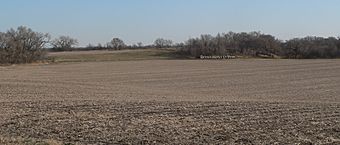Palmer Site facts for kids
|
Palmer Site
|
|

Vicinity of site, 2013
|
|
| Lua error in Module:Location_map at line 420: attempt to index field 'wikibase' (a nil value). | |
| Nearest city | Palmer, Nebraska |
|---|---|
| NRHP reference No. | 66000447 |
Quick facts for kids Significant dates |
|
| Added to NRHP | October 15, 1966 |
| Designated NHL | July 19, 1964 |
The Palmer Site, also known as the Skidi Pawnee Village, is an ancient place where Native Americans once lived. It's located near Palmer, Nebraska in Howard and Merrick Counties. This site was home to the Skidi people, a group within the larger Pawnee people. It might have been visited by an American expedition led by Stephen Harriman Long in 1820. The Palmer Site was recognized as a special National Historic Landmark in 1964. It is currently on private land.
Contents
Discovering the Palmer Site
The Palmer Site is an important archeological site that tells us about the past. It is also known by its scientific name, 25HW1. Archeologists believe people lived here mostly in the early 1800s.
What Was Found There?
When archeologists studied the site, they found many interesting things. They identified about 120 places where lodges, or homes, once stood. They also found a special area that looks like a council circle, which was likely used for meetings.
The site also includes a Native American burial ground. Some burials had to be moved because of road construction nearby. These findings help us understand how the Skidi Pawnee people lived long ago.
Early Explorers and the Village
The Palmer Site was visited by several expeditions in the 1800s. One of the first was led by Stephen H. Long in 1819-1820. His group explored along the Loup River and likely saw this village. They wrote down its location and other villages they found.
Another expedition came to the village in 1833. By 1844, a different group of explorers reported that the village was no longer active. This means the Skidi Pawnee people had moved on by then.
A Heroic Pawnee Leader
This village is believed to be the home of Petalesharo. He was a brave Pawnee warrior. Petalesharo is famous for stopping a traditional Skidi ceremony. During this ceremony, a young Comanche girl was going to be sacrificed. Petalesharo bravely rescued her.
Petalesharo's actions showed great courage and changed a long-standing custom. It is thought that Petalesharo himself might be buried at the Palmer Site. His story is an important part of Pawnee history.

